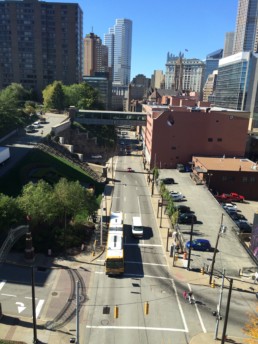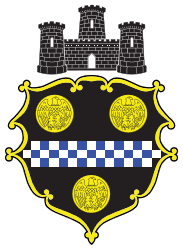Pittsburgh’s Low-Carbon Corridor seeks to revamp the city’s struggling Uptown neighborhood by targeting emissions and energy use reductions, along with active community engagement.
The City of Pittsburgh is reconnecting and revitalizing an underserved district with its two prosperous neighbors with the energy-saving and community development project Low-Carbon Corridor. The project will target emissions reductions along the transit corridor running through central Pittsburgh, while also focusing on making streets and public spaces safe, accessible, and enjoyable. Ultimately, the project aims to reduce emissions from transportation by 50% by 2030; 65 million square feet of commercial buildings are committed to reducing water and energy use by 50% by the same year. The project has already achieved a 6.3% reduction in energy use and a 10% reduction in water use.
388,000 tons of CO2 reduced by 2050 by reducing energy consumption 50% in Downtown and Oakland, and reducing transportation emissions 50% in Downtown
Cities100 – 2015
To achieve its goals, the Low-Carbon Corridor uses traditional methods, such as promoting public transit and bicycle use to limit driving, as well as smart technology, such as LED street lights that not only save energy but also measure air quality, temperature, and other indicators. To promote public involvement, the Uptown neighborhood has created an EcoInnovation District plan, which will entail 18 months of public participation to ensure that future land use, investment, and entrepreneurship create opportunities for all in the disadvantaged neighborhood.

The challenge
Despite its location between two thriving business districts, the Uptown neighborhood of Pittsburgh has not fared as well over the past several decades, and today it has an estimated 40% vacancy rate and an 80% poverty rate. But with more than 50,000 people traveling through Uptown daily, the Low-Carbon Corridor seeks to capitalize on this neighborhood’s potential to be economically profitable, socially equitable, and environmentally sustainable.
Co-benefits
Economic This project will attract new business and entrepreneurship to the area, and link residents to employment opportunities.
Environmental The Corridor promotes the use of alternative fueled vehicles by offering these cars priority parking and access to fueling stations.
Health In addition to the health benefits associated with improved air quality, this project will enable and encourage active transportation.
Social The Corridor allows for easier access to Downtown and Oakland’s rich cultural, commerce, and natural assets.
About Pittsburgh
Pittsburgh is a city in the Commonwealth of Pennsylvania in the United States. As of 2017, a total population of 305,704 lives within the city limits, making it the 63rd-largest city in the U.S. Pittsburgh is known as both “the Steel City” for its more than 300 steel-related businesses, and as the “City of Bridges” for its 446 bridges. The city features 30 skyscrapers, two inclines, a pre-revolutionary fortification and the Point State Park at the confluence of the rivers. In 2015, Pittsburgh was listed among the “eleven most livable cities in the world”.


